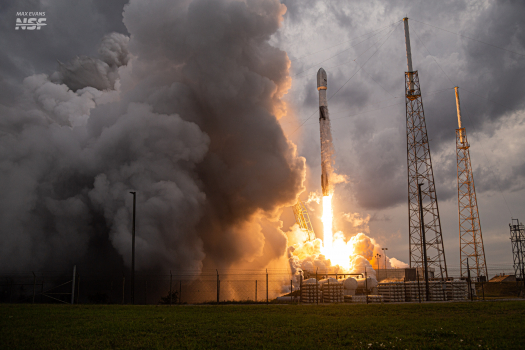04/09/2024
24 views
1 likes
According to recent research, Europe’s net greenhouse gas emissions have decreased by around 25% since the 1990s. While this is good news, the study also revealed a weakening in the capacity of land and vegetation to absorb and store atmospheric carbon.
The paper, published in the journal Global Biochemical Cycles, describes how a team of scientists compiled an up-to-date carbon budget for continental Europe for the three main greenhouse gases – carbon dioxide, methane and nitrous oxide – over three decades: the 1990s, the 2000s and the 2010s.
The study was partly funded by ESA and the Horizon Europe project EYE CLIMA, and is part of ESA’s Regional Carbon Cycle Assessment and Processes Phase 2 (RECCAP-2) project.
The research included combining satellite measurements and atmospheric models to quantify fluxes, meaning the movement of these three gases between the land and the atmosphere. In line with current Intergovernmental Panel on Climate Change guidelines, the researchers also estimated emissions from fossil fuel burning, industrial production, waste management and agriculture.
Taking into account that one tonne of emitted methane or nitrous oxide has a stronger climate impact than one tonne of carbon dioxide, the authors estimated annual greenhouse gas net-emissions for the 2010s that have the equivalent warming potential of 3.9 billion tonnes of carbon dioxide.
This net emission was dominated by direct emissions from human activity, 85% of which were from the burning of fossil fuel.
Comparing the 2010s against the previous two decades, the researchers found that, overall, emissions had declined by around a quarter – by about 1.2 billion tonnes of carbon dioxide equivalents per year.
Ronny Lauerwald, from the Paris-Saclay University in France, said, “The decline of emissions is mainly due to a reduction in the energy required to drive economic growth and the decline of carbon dioxide emissions in the energy mix, with more renewable energies being used while many coal-fuelled power plants have closed.”
The research team also found that the land acted as a net sink for carbon dioxide during 2010s, drawing down from the atmosphere 0.9 billion tonnes of carbon dioxide equivalents per year.
However, the authors found evidence that the ability of the land and vegetation to draw and store carbon dioxide from the atmosphere has weakened since the 2000s.
Dr Lauerwald commented, “The weakening of the land carbon sink is caused by an accelerated increase in the emission of carbon dioxide from the biosphere, which is not counterbalanced by a concomitant increase in carbon dioxide uptake by vegetation, as in the decades before.
“In particular, forest disturbances have increased in the last thirty years. In contrast, the carbon dioxide uptake by vegetation has stagnated since the 2000s.”
This finding underlined the need to better understand and develop existing carbon monitoring frameworks to accurately predict and account for dynamic changes resulting from land-use change and natural disturbances.
Using the top-down inversion approach in combination with bottom-up inventory estimates and remote sensing of forest, such as the ESA Climate Change Initiative’s global biomass dataset, the study aimed to gain a better understanding of greenhouse gas land sinks and sources distributed across Europe’s ecosystems and how they have evolved over the past decades.
They found a large part of Europe’s carbon and carbon dioxide sinks were in the northern half of Europe.
At the same time, the authors found a decline in sink strength in Scandinavia, which can be attributed to an increase in forest management along with perturbations such trees being uprooted by the wind and outbreaks of the bark beetle pest.
These losses were partly offset by carbon dioxide sinks that strengthened in parts of eastern Europe and northern Spain, attributed in part to land-use change.
Agricultural activity, namely ruminant livestock and the use of fertiliser and manure were found to be significant sources of methane and nitrous oxide emission across Belgium, the Netherlands and southern United Kingdom.
In contrast to a clear overall declining trend in methane and nitrous oxide emissions over the three decades, much more pronounced interannual variability was found regarding the land carbon dioxide budget, with natural disturbances considered a significant factor.
Ana Bastos, from the Max-Planck-Institute for Biogeochemistry in Germany, said, “Climate variability, and especially extreme events, influence much of the fluctuations in the European carbon sink. We have seen that major heat and drought events, like in summer 2003, 2018 and 2019, have even switched carbon sinks into temporary sources due to fires, drought-induced tree mortality and pest outbreaks.”
Philippe Ciais, from the Laboratory for Climate and Environmental Sciences in France, noted, “By comparing our estimates with those of UNFCCC reports, our study provides a key contribution to the evaluation of national reporting of greenhouse gas and carbon emissions on a continental scale.
“Moreover, our study helps to set the path towards an improved carbon monitoring framework at the European scale that can guide policy making.”
This study marks the latest collaboration between ESA and the Global Carbon Project for global and regional greenhouse gas budgets, science and assessment.
“In addition to work on carbon budgets, this successful collaboration has advanced the science around forest carbon exchange while also developing cutting-edge methods that exploit satellite observations to improve consistency with national greenhouse gas reports submitted to the UNFCCC, and demonstrates progress on climate mitigation action,” explains Clement Albergel from ESA’s Climate and Long-Term Action Division.
Building on these achievements, ESA is launching a new three-year project, Climate Space RECCAP-2. This follow-on research will focus on reducing uncertainty relating to carbon dioxide and methane emissions and removals from the atmosphere across key regions, including Europe, Siberia, the Amazon and the Arctic, to better address global warming.




